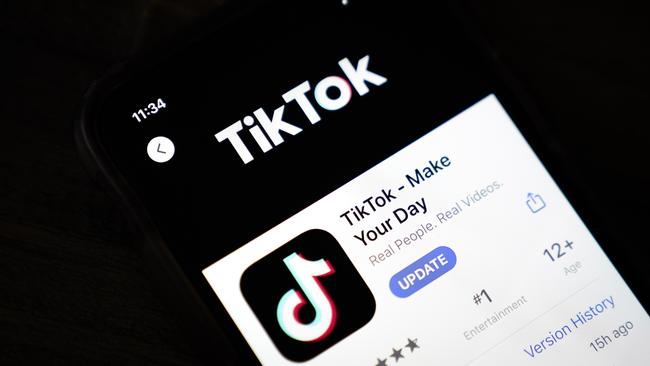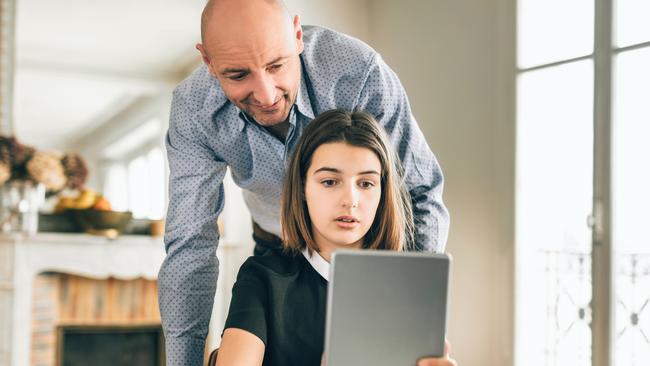The important lesson for parents after kids exposed to a TikTok video depicting suicide
A disturbing video did the rounds on social media app TikTok this week, and while it’s too late for children to un-see the alarming clip it does serves as an important wake-up call for parents, writes Susie O’Brien.

Susie O'Brien
Don't miss out on the headlines from Susie O'Brien. Followed categories will be added to My News.
Kids and teenagers who innocently clicked on a photo of a fluffy white puppy on social
media this week instead were confronted with a graphic video of a man ending his life.
Other young people accessed the distressing clip after it appeared in their curated “for you”
feed of the video-sharing app TikTok.
Kids and teens are going through enough without a live suicide ending up in their social
media feeds. It’s horrifying and sickening.
Cyber safety experts told parents to keep their kids off TikTok for 24 hours while the clip
was removed.
This is a sensible idea, but we’re kidding ourselves if we think removing phones or blocking
access to such sites for a day is going to keep our kids safe.
As the Christchurch massacre taught us, livestreaming content can be very difficult to
remove once it’s online. Major social media sites can’t — or won’t — control clips once they go viral. This means it’s up to us.
Warnings often come too late. The clip, which shows a 33-year-old American army veteran
called Ronnie McNutt, first appeared on Facebook as far back as August 31.
Kids were viewing it on TikTok for at least 24 hours before any official warnings were issued.
While parental action is vital, there is no substitute for kids making savvy and safe choices.
We have to teach them to spot, ignore, deal with and report harmful material for
themselves.

eSafety Commissioner Julie Inman Grant is right to suggest that warnings and bans end up
fuelling interest in such clips among young people.
She urges parents to “keep an eye on those who are more vulnerable and at-risk, and check
in with them about their interactions on and offline”.
This is a much better approach than taking phones away at the first hint of a problem.
If kids think they will have their phones removed them the minute they raise something
inappropriate or violent, then they won’t tell us anything at all.
Rather than sharing or watching the clip, smart teens instead warned each other to swipe
away from a video that appeared to be of a man with a grey beard sitting at a desk.
In posts I’ve seen, they told each other to “Pause it and if you’re not sure, don’t keep watching it. If
you want to know more, then read the comments, this will tell you what’s in it,” they said.
“If it’s the suicide clip, then report it. Don’t like it and don’t comment on it.”
One wise voice is Martine Oglethorpe, author of The Modern Parent and a Trusted eSafety
Provider. She suggests parents need to make sure children are aware that they may come
across material that is not suitable for them, and which may be uncomfortable or
disturbing. She suggests talking to them about it rather than lecturing them about what
they’re doing wrong.
Efforts to keep kids off social media — especially older kids — are doomed. We must arm
them with common sense and knowledge of the real world and make sure they have good
social networks.

We must also become involved in their online lives and familiarise ourselves with the apps
and platforms they’re spending hours on every day.
This is a also a reminder that age guidelines on social media exist for a reason. These days,
kids a lot younger than 13 have mobile phones, and many of them are on social media.
TikTok is regularly used by kids as young as eight, especially girls.
Of course, parents can’t do it all, and this latest case has shown that social media platforms
need much better tools to identify and remove harmful material
TikTok says it has systems for “automatically detecting and flagging these clips for violating
our community guidelines”.
Given that the clip has been out there for at least a week, it’s clear these systems aren’t
working all that well.
The video comes at a terrible time for our kids and young people. University of Sydney
researchers predict suicides in young people aged 15 to 25 will rise 30 per cent in the next
five years. A so-called suicide cluster on Sydney’s north shore has spooked many parents
worried about their anxious teenagers who, since lockdown, have been refusing to eat
properly or won’t get out of bed.
This is why parents need to do more than just remove any offending content or take away
phones.
We need to help our kids manage material for themselves and make good decisions because
we are not always going to tell them what to watch — or what not to watch — on social
media.
Report harmful material to www.esafety.gov.au/report/illegal-harmful-content
For 24/7 phone and online counselling for people aged five to 25, ring Kids Helpline on 1800 551 800 or www.kidshelpline.com.au
Susie O’Brien is a Herald Sun columnist

